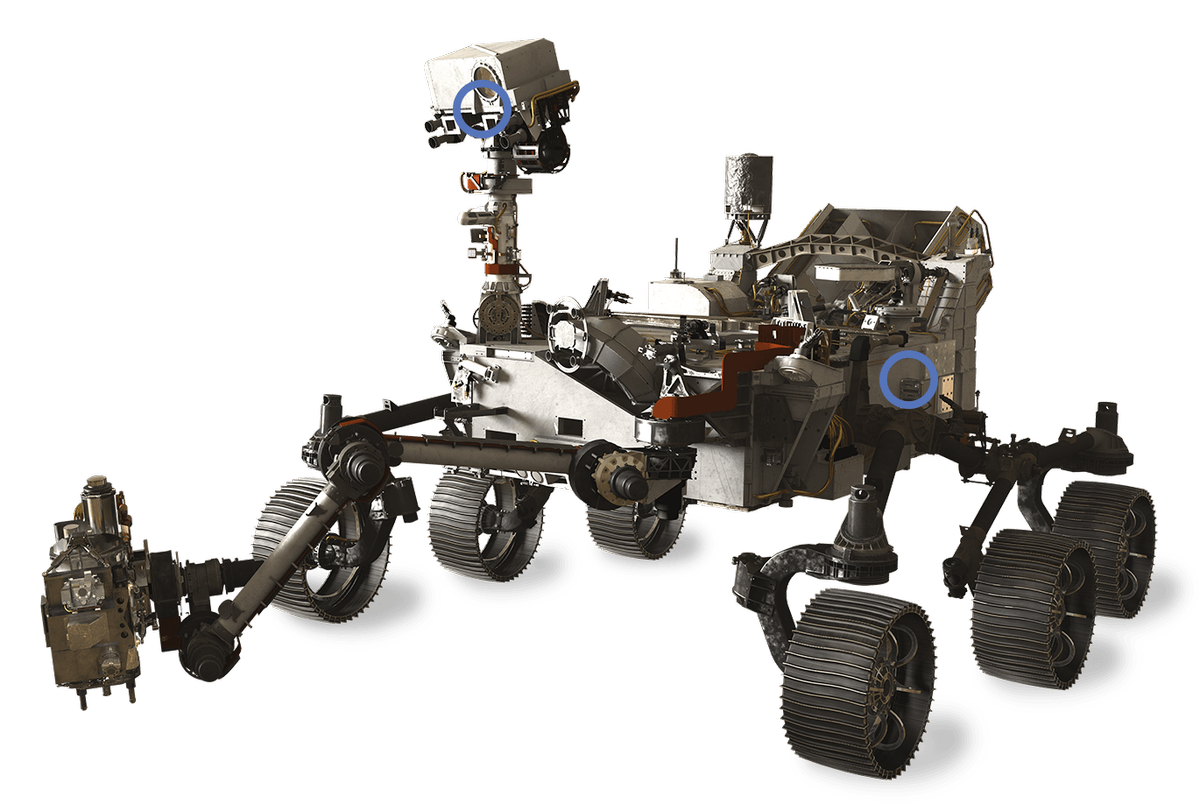
For the first time ever, mission planners hope, NASA's Perseverance rover will collect the sounds of Mars — starting as the spacecraft plummets through the atmosphere to its landing site at Jezero Crater.
Perseverance will land on Feb. 18, 2021, during a risky touchdown sequence similar to that of its predecessor Curiosity, which survived "seven minutes of terror" in 2012 using parachutes and a "sky crane." The mics aboard Perseverance will capture the sounds of this epic landing, then help guide the rover in its science investigations on the surface.
The two microphones attached to Perseverance mean that when the rover arrives, it will be able to hear Mars, not just see, touch and "taste" (chemically analyze) it as its predecessors have done.
In photos: NASA's Mars Perseverance rover mission to the Red Planet
One of the mics will fly on Perseverance's entry, descent and landing (EDL) system. Engineers will listen in as Perseverance pops its parachutes in the thin atmosphere of Mars, while precisely targeting where it wants to alight on the surface.
The "brains" of the EDL mic are safely nestled in the body of the rover, communicating with the "ear" on the side of the rover's body. That ear will listen to wind and dust rushing by during the perilous landing process and may hear atmospheric friction that the spacecraft experiences.
But this microphone will likely be short-lived, according to a NASA document, because it was made with typical store-bought hardware. The Perseverance team expects that the EDL mic will only hear the landing itself, although it may hear the wind and pick up some rover noises like turning wheels, motors and heat pumps, if it does survive the difficult descent.
A second microphone is part of the SuperCam system, which will shoot a laser at rocks to penetrate them and examine their composition. One of SuperCam's goals is to identify organic compounds that could be related to past life on Mars, making the instrument essential to Perseverance's larger aim, to figure out how habitable Mars was for microbes in the ancient past.
The microphone will give scientists additional information about what SuperCam is studying, according to the same NASA document. Just as the instrument's laser vaporizes rock to create something for SuperCam's light-recording instruments to study, so too the vaporizing will create a "popping" shockwave that the microphone will record from its safe location on the rover itself. By analyzing that "pop," scientists can measure the hardness of the vaporized rock, which offers clues about its formation.
SuperCam's mic can tune in for about 3.5 minutes at a time during these routine science observations, according to NASA. Scientists expect that the laser vaporizing its targets will not be the only sound the microphone picks up. Other captured noises may include sand grains scraping on the Martian surface, wind funneling around the rover mast, and perhaps — if the rover is in the right place at the right time — the "howls" of dust devils in the near distance, which previous rovers have seen but not heard.
The microphone may also capture sounds of Perseverance's activities, such as its wheels turning in the dust, its arm moving around or its instruments and sampling mechanisms in use. The mic's eavesdropping means that if one of these systems happens to fail, recorded sounds could help engineers diagnose and mitigate what went wrong, along with the standard photos and videos Perseverance will send back from the surface.
While eight previous spacecraft have made it safely to the surface of Mars, none of them have been able to deploy mics. Either such technology wasn't on board the spacecraft in the first place or the equipment or spacecraft failed.
(NASA's InSight lander recorded the "sounds" of the Martian wind in 2018, but that wasn't a true audio recording. Instead, it was sonified, manipulated data from an air pressure sensor and a seismometer aboard the lander.)
Microphones have launched to Mars twice before. One was tucked aboard NASA's Mars Polar Lander mission, which crashed during landing in 1999. The other Martian mic flew with the Phoenix lander, which landed flawlessly in 2008, but NASA turned the mic off before landing due to technical problems.
The Planetary Society, which designed the mic on the Mars Polar Lander, said in a statement that it is eager to finally hear the sounds of Mars after patiently waiting more than 20 years.
"We've been able to see Mars from the rovers' point of view for a long time now," Greg Delory, the CEO and co-founder of space hardware company Heliospace, said in the statement. Delory advises the SuperCam microphone team and helped design the Planetary Society's 1999 Mars mic.
"To be able to add another sense to our understanding of Mars is going to be incredible," he said.
Follow Elizabeth Howell on Twitter @howellspace. Follow us on Twitter @Spacedotcom and on Facebook.
"hear" - Google News
July 30, 2020 at 03:00AM
https://ift.tt/2P6oEPp
The sounds of Mars: NASA's Perseverance rover packs microphones to hear the Red Planet - Space.com
"hear" - Google News
https://ift.tt/2KTiH6k
https://ift.tt/2Wh3f9n
Bagikan Berita Ini














0 Response to "The sounds of Mars: NASA's Perseverance rover packs microphones to hear the Red Planet - Space.com"
Post a Comment